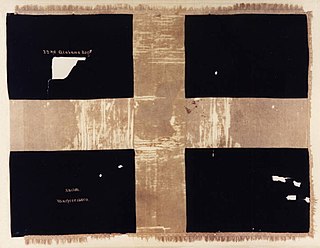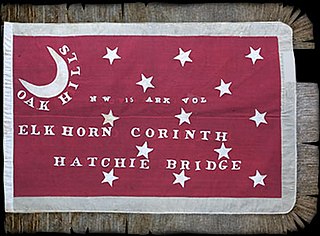A. P. Hill's Light Division was an infantry division in General Robert E. Lee's Confederate Army of Northern Virginia during the American Civil War. Originally including six brigades, the Division's first commander starting May 27, 1862 was then Major General A. P. Hill. Major Generals William Dorsey Pender and Cadmus M. Wilcox commanded a reorganized Light Division in the Army of Northern Virginia after Hill's promotion to corps command and Pender's death at the Battle of Gettysburg, respectively.

The 22nd Alabama Infantry Regiment was an infantry regiment that served in the Confederate Army during the American Civil War.

Claudius Wistar Sears was a United States Army officer, an educator, and a Confederate general during the American Civil War.
The 3rd Kentucky Infantry Regiment was a volunteer infantry regiment that served in the Confederate States Army during the American Civil War. It was part of the First Kentucky Brigade through August 1862.

The 25th Arkansas Infantry was an infantry regiment of the Confederate States Army during the American Civil War. The unit was originally organized as Turnbull's 11th Arkansas Infantry Battalion. Upon being increased by the required number of companies the battalion was organized as the 30th Arkansas Infantry Regiment but was later redesignated as the 25th Arkansas Infantry. There were two regiments officially designated as the 30th Arkansas Infantry. The other "30th Arkansas" served west of the Mississippi River, in the Department of the Trans-Mississippi and was also known as 5th Trans-Mississippi Regiment or the 39th Arkansas or Rogan's Arkansas Cavalry during Price's 1864 Missouri Expedition.

The 15th (Northwest) Arkansas Infantry Regiment (1861–1865) was a Confederate Army infantry regiment during the American Civil War. The unit was originally formed as the 3rd Arkansas Infantry Battalion. After receiving the required 10 companies, the unit was redesignated as the 21st (McRae's) Arkansas Infantry Regiment. Upon recognition that there was already a 21st Arkansas, the unit was again redesignated as the 15th Arkansas Infantry Regiment. This was the third Arkansas unit to bear the designation "15th Arkansas". The others are the 15th (Josey's) Arkansas Infantry Regiment and the 15th (Gee/Johnson) Arkansas Infantry Regiment. The unit saw action both west and east of the Mississippi, before serving in the Vicksburg campaign. The regiment was surrendered at Vicksburg in July 1863. After being paroled and exchanged, the regiment was consolidated with other depleted Arkansas regiments to form the 1st (Trans-Mississippi) Arkansas Consolidated Infantry Regiment.

The 9th Arkansas Infantry Regiment was a regiment of the Confederate States Army during the American Civil War. It served in the Western Theater, seeing action in the Vicksburg, Tennessee and Georgia campaigns. Due to attrition; the 9th Arkansas was consolidated several times with other Arkansas regiments, finally merging in 1865 into the 1st Arkansas Consolidated Mounted Rifles.
The 1st Arkansas Consolidated Infantry (Trans-Mississippi) (1864–1865) was a Confederate States Army infantry regiment during the American Civil War. The regiment is separate from and has no connection with the 1st Arkansas Consolidated Infantry Regiment which was formed in the Confederate Army of Tennessee in April 1865 and is also separate from the 1st Regiment, Arkansas State Troops, which became the 15th (Josey's) Arkansas Infantry Regiment and Fagan's 1st Arkansas Infantry Regiment, which was formed in 1861 and served in the Army of Tennessee.
The 19th Arkansas Infantry Regiment or Dockery's Arkansas Infantry Regiment was an infantry formation of the Confederate States Army during the American Civil War. There were two other regiments which were designated as the 19th Arkansas. Dawson's 19th Arkansas Infantry was organized at Nashville, Arkansas, on November 21, 1861. Hardy's Arkansas Infantry, which is also occasionally referred to as the 19th Arkansas was organized in 1863 from those parts of Dawson's 19th Infantry Regiment, the 24th Arkansas Infantry Regiment and Crawford's Arkansas Infantry Battalion, which escaped capture at the Battle of Arkansas Post.
The 20th Arkansas Infantry (1861–1865) was a Confederate Army infantry regiment during the American Civil War. The unit was also known as the 22nd Arkansas Infantry. When the unit was reorganized following its capture at the Siege of Vicksburg, it was officially redesignated as the 41st Arkansas Infantry (Mounted), by the Arkansas State Military Board, but this redesignation was completely ignored by the unit and Confederate authorities. The unit participated in the Camden Expedition and Price's Missouri Expedition as a mounted infantry unit.
The 21st Arkansas Infantry (1862–1865) was a Confederate Army infantry regiment during the American Civil War. The unit was organized from the consolidation of two understrength Arkansas units in May 1862. The unit participated in the Iuka-Corinth Campaign before becoming part of the garrison of Vicksburg Mississippi. After the capitulation of Confederate forces at Vicksburg, the 21st was paroled and exchanged back to Arkansas where it was combined with the remnants of several there Arkansas regiments to become the 1st Arkansas Consolidated Infantry Regiment (Trans-Mississippi). Another Arkansas Confederate infantry regiment, commanded by Colonel Dandridge McRae was also labeled the "21st Arkansas". To avoid confusion between two 21st Arkansas Regiments, McRae's regiment was later redesignated as the 15th (Northwest) Arkansas Infantry Regiment.

The 11th Regiment Illinois Volunteer Infantry was an infantry regiment from Illinois that served in the Union Army during the American Civil War. In April 1861, it was formed as a three-month volunteer unit, and in July 1861 it was reorganized as a three-year unit, in which role it served until the end of the war. Two of its commanding officers were promoted to brigadier general and led major units during the war. In its first major action at Fort Donelson the regiment suffered terrible losses. The 11th Illinois also fought at Shiloh, Riggins Hill, Vicksburg, First Yazoo City, Second Yazoo City, and Fort Blakely. In April 1863, the 109th Illinois Infantry Regiment was disbanded and its enlisted men transferred into the 11th Illinois. The regiment was mustered out of service in July 1865.
Company B, 1st Tennessee Heavy Artillery (1861-1864) was a Confederate Army artillery battery during the American Civil War. While the unit was assigned to a Tennessee Artillery Regiment, it was originally organized as the McCown Guards or the McCown Guards Artillery, a volunteer company organized in Lafayette County, Arkansas. Also known as: Company A, 1st Tennessee Heavy Artillery and/or Dismukes' Battery.
The 1st Arkansas Cavalry Battalion (Stirman's) (1864-1865) was a Confederate Army cavalry battalion during the American Civil War. The unit was also known as Brooks 1st Arkansas Cavalry Battalion, Stirman's, 1st Arkansas Cavalry Battalion, Stirman's Sharpshooter Regiment, 1st Regiment Arkansas Sharpshooters, and finally simply as Stirman's Arkansas Cavalry Regiment.
The 62nd Tennessee Infantry Regiment, also known as 62nd Tennessee Mounted Infantry and 80th Tennessee Infantry Regiment, was an infantry regiment in the Confederate States Army during the American Civil War. It served on Mississippi, Tennessee, West Virginia, Maryland and Virginia and surrendered at Washington, Georgia on May 9, 1865 as part of Jeff Davis escort.
The 1st and 4th Missouri Infantry (Consolidated) was an infantry regiment that served in the Confederate States Army during the American Civil War. The regiment was formed on November 7, 1862 when the 1st Missouri Infantry and the 4th Missouri Infantry were consolidated as a result of heavy battle losses in both units. The regiment served in several battles in the 1863 Vicksburg campaign, including a charge that almost broke the Union line at the Battle of Champion Hill. When the Siege of Vicksburg ended with a Confederate surrender, the regiment was captured and later exchanged. In 1864, the regiment fought in the Atlanta campaign, and suffered heavy losses at the Battle of Franklin. On April 9, 1865, the regiment surrendered at the Battle of Fort Blakely, and was paroled in May when the war ended for all effective purposes.

The 6th Missouri Infantry was an infantry regiment of the Confederate States Army during the American Civil War. The regiment was formed on August 26, 1862, when two existing units were combined. Later that year, the regiment was then lightly engaged at the Battle of Iuka and saw heavy action at the Second Battle of Corinth. In 1863, the regiment was engaged at the Battle of Port Gibson, and was part of a major charge at the Battle of Champion Hill. After a defeat at the Battle of Big Black River Bridge, the regiment took part in the siege of Vicksburg, where it saw heavy fighting. The siege of Vicksburg ended on July 4th with a Confederate surrender; after being exchanged, the regiment combined with the 2nd Missouri Infantry to form the 2nd and 6th Missouri Infantry (Consolidated). The 6th Missouri Infantry ceased to exist as a separate unit.
The 2nd Missouri Infantry Regiment was an infantry regiment that served in the Confederate States Army during the American Civil War. Organized on January 16, 1862, the regiment first saw major action at the Battle of Pea Ridge on March 7 and 8, 1862. After Pea Ridge, the regiment was transferred across the Mississippi River, fighting in the Battle of Farmington, Mississippi on May 9. The unit missed the Battle of Iuka in September, but was heavily engaged at the Second Battle of Corinth on October 3 and 4. The regiment helped drive in a Union position on October 3. On October 4, the 2nd Missouri Infantry, along with the rest of Colonel Elijah Gates' brigade, captured a fortification known as Battery Powell, but were forced to retreat by Union reinforcements.
The 3rd Missouri Infantry Regiment served in the Confederate States Army during the American Civil War. The infantry regiment was officially mustered into service on January 17, 1862. It fought at the Battle of Pea Ridge in Arkansas in March before being transferred across the Mississippi River. While stationed at Corinth, Mississippi, the regiment played a minor role in the Battle of Farmington before the evacuation of the town. In September, the unit saw light action at the Battle of Iuka before being heavily engaged during the Second Battle of Corinth as the Confederates attempted to retake the town in October. In early 1863, the regiment was transferred to Grand Gulf, Mississippi, in order to strengthen the defenses of the Mississippi River at that point. At the Battle of Grand Gulf on April 29, the unit helped repulse a Union Navy attack against the Confederate defensive works. After elements of the Union Army of the Tennessee landed below Grand Gulf, the regiment fought in a delaying action at the Battle of Port Gibson on May 1.
The 2nd and 6th Missouri Infantry Regiment (Consolidated) was an infantry regiment that served in the Confederate States Army during the American Civil War. The regiment was formed on October 6, 1863, when the 2nd Missouri Infantry Regiment and the 6th Missouri Infantry Regiment were consolidated. The regiment first saw major action in the 1864 Atlanta campaign, fighting in the battles of Kennesaw Mountain and Peachtree Creek, the Siege of Atlanta, and several smaller actions. After the Confederates retreated from Atlanta, the regiment was part of a force that made an unsuccessful attack against a Union garrison during the Battle of Allatoona on October 5. The regiment then followed General John Bell Hood's Confederate Army of Tennessee into Tennessee, where it charged the Union works at the Battle of Franklin on November 30. At Franklin, the regiment suffered over 60 percent casualties, including the loss of many company commanders. After Franklin, the regiment was detached from the rest of the army to build fortifications, missing the Battle of Nashville. In March 1865, the regiment was transferred to Mobile, Alabama. On April 9, 1865, the regiment was captured at the Battle of Fort Blakely; the survivors of the regiment were paroled at Jackson, Mississippi in May after the Army of Tennessee surrendered.








